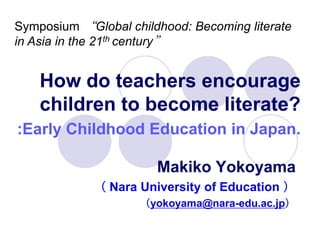
Global childhood: Becoming literate in Asia
- 1. Symposium “Global childhood: Becoming literate in Asia in the 21th century” How do teachers encourage children to become literate? :Early Childhood Education in Japan. Makiko Yokoyama ( Nara University of Education ) (yokoyama@nara-edu.ac.jp)
- 2. ● Contents 1.What is “Literacy” in Japan? (1)Literacy definition (2)How do Japanese children become literate? 2.Literacy practices in early childhood education in Japan (1)ECE facilities in Japan (2)National Curriculum Standard (3)Children’s activities 3.To develop our investigation ! ;“Becoming literate throughout life”
- 3. 1. What is “ Literacy ” in Japan? (1)Literacy definition 読み書き能力・リテラシー The ability to read and write Japanese. にほんご ・ ニホンゴ ・ 日本語 Literacy rate(age 15 and over) total population: 99% male: 99% ・ female: 99% (2002)
- 4. 1. What is “ Literacy ” in Japan? (2)How do Japanese children become literate? Almost all the children in Japan can read Hiragana before starting elementary school(National Institution for Japanese Language and Linguistics,1967). Children acquire literacy through How ? watching and participating literacy activities in everyday life (Uchida,1999).
- 5. 2.Literacy practices in early childhood education in Japan (1)ECE facilities in Japan Sourse:Otani (2010) Kindergarten Day-Care centre From age 3 to 6 From age 0 to 6 (before entering primaly school) (before entering primaly school) Target * Children with needs for care (Eligibility determ i by m uni pal governm ents) ned ci Childcare 4 hours a day, as educational standard 8 hours a day, in principle Time Legal School Education Act Child Welfare Act Foundation Governing Ministry of Education, Culture, Sports, Ministry of Health, Labour and Welfare Body Science and Technology (MEXT) (MHLW) National Curriculum Standards for Standards Day Care Guideline Kindergartens
- 6. (2)National Curriculum Standard; “Course of Study for Kindergarten(2008)” ① Basic Ideals of Kindergarten Education Fundamental aim: Educating young children through their environment Emphasized points: teachers’ Not educating by Encouraging children to undertake direct instructions voluntary activities Through play-centered instruction Responding to the individual characteristics of each children
- 7. ●Five Contents of Early Health physical and Childhood mental health Education Human relationships Expression the relationship feeling and between the child and expression other people Language Environment children's the process of suroundings, and language relationship to them acquisition
- 8. (1)“ Courses of Study for Kindergarten (2008 )” ② Content;Language -1 1. Aims (1) To experience the enjoyment of expressing personal feelings in their own words. (2) To listen closely to other people, to verbalize experiences and thoughts, and to enjoy communicating. (3) To have a grasp of the language necessary for everyday life, to be familiar with picture books and stories, and to communicate feelings with teachers and friends.
- 9. (1)“ Courses of Study for Kindergarten (2008) ” ② Content;Language - 2 Keywords: 2. Content enjoyment, necessary, (10) Experiencing the enjoyment of conveying experience, in everyday life. thoughts and feelings in writing ・・・・ 3. Dealing with the Content Teacher’s role: (4) Teachers should encourage children to experience thea learning environment Create pleasure and enjoyment of conveying thoughts and feelings through written for children to participate in words, and to develop an interest in and curiosity voluntary. about written words in their everyday life.
- 10. (2)Children’s activities How do Kindergarten teachers encourage children to become literate ? Method: Observation and interview ①Objects:children and teachers in the Kindergarten attached my University ②procedure: ・Observation:once a week, with taking notes and recording by digital- and video-cameras. ・interview: once a term, for teachers. ③points of analyses ・environment of letters ・children’s literacy activities(children・teachers)
- 11. ①Environment of letters. Shoes boxes(2nd grade:4 & 5-year-olds) Mark & Name
- 12. ①Environment of letters. Pictures & Letters Goods of playing at housekeeping (outdoor).
- 13. ① Environment of letters : How to make an Origami. May.01 2008(Third grade class)
- 14. ②Children write letters in play: tools of communication. (2)Write letters together. (1)Exchange letters which wrote at home. Sep.07 2011 (Second grade class, they are 5years old.
- 15. ②Children write letters in play; tools of play. Play Juice Shop. May.01 2008(Third grade class, they are 5years old.)
- 16. ②Children write letters in play. Hiragana Stamps. Jan.23 2009 (Third grade class)
- 17. ③Conclusion ①environment of ②Children’s letters activities Letters shows with Voluntary marks or pictures. Learning through the play They are different Enjoyment , necessary from grades. With friends ③Teachers’ Roles Creating environments for children’s voluntary activities. Preparing materials which enhance activities. Ensuring space and time for activities.
- 18. 3.To develop our investigation ! After starting school years, in becoming literate, ①Have environment of letters played important roles, too ? ②What are the roles of teachers ? ③What are the roles of friends ?